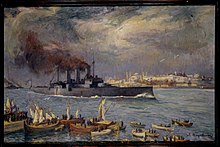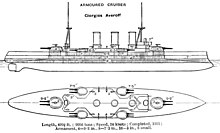Georgios Averoff (ship, 1910)
|
Armored cruiser Georgios Averoff
|
||||||||||||||||
|
||||||||||||||||
|
||||||||||||||||
|
||||||||||||||||
|
||||||||||||||||
The Georgios Averoff ( Greek : Γεώργιος Αβέρωφ ) is an armored cruiser that was the flagship of the Greek Navy for more than forty years from 1911 . Laid down in Italy as an armored cruiser of the Pisa class in 1910, the ship fought in four wars and played an important role in modern Greek history. Although it is commonly known as the “ battleship ” (θωρηκτό or English: “battleship”), as is the case in parts of the literature , it is actually an armored cruiser (θωρακισμένο καταδρομικό or English: “armored cruiser”). The Georgios Averoff is now a museum ship and the last heavy armored cruiser in the world that is still floating.
procurement
At the beginning of the 20th century, the Kingdom of Greece tried to radically modernize its completely outdated naval forces in order to maintain its position in the Balkans against the Ottoman Empire , but also against its allies Serbia and Bulgaria . Four new, modern destroyers were procured for the Royal Hellenic Navy , but the most important project was without a doubt the Georgios Averoff .
The armored cruiser was commissioned by the Italian Regia Marina (Royal Italian Navy) as the fourth ship of the Pisa class from the Orlando shipyard ( Cantiere Navale Fratelli Orlando ) - internationally also known as Orlando Shipyards - in Livorno . After the keel was laid in February 1909, the Regia Marina canceled the order for cost reasons and continued construction was suspended for the time being. The Greek government, which until then had not the wishes corresponding larger warship had found or commissioned, found out about it and jumped then quickly, said the ship in November 1909 with a deposit of only 300,000 pounds Sterling took over. The new armored cruiser was equipped with a combination of components from various manufacturers after consultation with the Greeks. The 22 coal-fired steam boilers of the Belleville type and the two four-cylinder expansion steam engines came from Babcock from France , the heavy armament from Armstrong from Great Britain , the fire control system for the most part from the German Reich and everything else from Italy, including the one after Krupp - Armored material produced by the process. The arrangement of the middle artillery was also progressive, as it was not set up in individual casemates on the lower deck, but in towers. This meant that she was still fully usable even in rough seas.
As a result, the Georgios Averoff was slightly less armed (main caliber 234 mm instead of 254 mm), but more heavily armored and equipped with a higher quality fire control system than the original ships of the Pisa class . She entered service on September 1, 1911 and, as the largest and most powerful Greek warship, immediately became the new flagship of the Royal Greek Navy .
The name
The ship was named after Georgios Averoff , a Greek businessman and philanthropist. In his will he had stipulated that after his death (1899) 20% of his inheritance should be donated to the Greek army treasury for the purchase of a warship, which at the time corresponded to an amount of 8 million drachmas . The ship was supposed to serve as a " sea cadet school " and was to bear his name. The then Greek government of Kiriakoulis Mavromichalis (Κυριακούλης Μαυρομιχάλης) paid the remaining part of the purchase price totaling 22.3 million drachmas.
Calls

The purchase of the most modern and powerful ship in the Aegean quickly paid off, as the ship was far superior to other ships in terms of armament, armor and speed. In the first Balkan War , Georgios Averoff practically pushed the completely disorderly retreating opposing fleet in the Aegean Sea at the first and second clash with the Ottoman Navy , i.e. in the battle of Elli on December 3, 1912 and the battle of Limnos on January 5, 1913 single-handedly into the Dardanelles . Rear Admiral Pavlos Koundouriotis often used the Georgios Averoff in the role of a battleship due to its superiority over all enemy and allied units, as it could operate better on its own than in a formation due to its higher speed. The armored cruiser severely damaged the enemy units, but suffered almost no damage itself. All the islands of the Aegean that were seaward of the battlefield and were inhabited by the Greeks fell into Greek hands.
During the immediately following World War I , in which the Georgios Averoff was only rarely used, as Greece was initially neutral and only joined the Allies in 1917 , it secured the Greeks supremacy over the Turkish Navy, which embarked on modernizing its fleet had, but could not perform in the short time. Even during the Greco-Turkish War that followed the defeat of the Ottoman Empire in World War I , the armored cruiser continued to ensure sea supremacy for Greece in the Aegean Sea and made any maritime activities in Turkey impossible from the start. After the defeat of the Greeks in this war, Georgios Averoff helped evacuate Greek soldiers and refugees from Smyrna (today: İzmir) and other cities in Western Anatolia .
In the interwar period, the Georgios Averoff was overhauled on a large scale for the first time in France between 1925 and 1927. It received modern anti-aircraft weapons , a new main mast and an improved fire control system. Furthermore, the now obsolete front torpedo tubes have also been removed. As the largest and most powerful Greek warship, she remained the naval flagship after the purchase of one or more larger units was no longer practical for budgetary reasons, especially after the Great Depression of 1929.
During the Second World War , the Georgios Averoff was first withdrawn to Crete and later to Alexandria , where it joined the British Royal Navy . She escaped the attacks of the German Air Force , which sank most of the Greek warships during the occupation of Greece by the Wehrmacht . A little later, the Georgios Averoff was relocated to Bombay , from where she mainly did convoy service during the war.
After Athens was liberated in 1944, the Greek government in exile brought them back to the capital.
Until it was decommissioned in 1952, the Greek fleet command was stationed on the Georgios Averoff . Since 1984 she has been a museum ship as part of the Trokadero Marina Ship Museum in the port of Paleo Faliro , near Athens. The Georgios Averoff continues to set sail for events mostly in summer.
The myth of Georgios Averoff
The Georgios Averoff has become a national myth through her operations in the Balkan Wars and World War I, where she inflicted heavy losses on her enemies without ever being seriously damaged. To this day, the Georgios Averoff is the only inactive ship allowed to carry the flag and jack of the Greek Navy.
Its best-known commander, Admiral Pavlos Koundouriotis, was elected viceroy and president of Greece several times , also because of his success with Georgios Averoff , and is still one of the most important national heroes of Greece alongside Eleftherios Venizelos .
The Georgios Averoff March , which is still played on official occasions of the Greek Navy, was composed in honor of the famous ship . In 2012 it served as the backdrop for the German feature film Die Männer der Emden .
literature
- Ronald Hopp: film set and visitor magnet. The cruiser GEORGIOS AVEROFF presented itself as a realistic film set in the port of Piraeus for the feature film "The Men of EMDEN". The armored cruiser from the early 20th century is one of the last of its kind , in: Schiff Classic. Magazin für Schifffahrts- und Marinegeschichte , vol. 1, 2013, pp. 36–41.
- B. Weyer (ed.): Taschenbuch der Kriegsflotten , XV. Born 1914, Munich 1914, pp. 68 f., 244, 385.
Web links
- Presentation of Georgios Averoff in writing and pictures (Greek) - Official website of the Georgios Averoff Naval Museum
- The ship
- Picture tour on steelnavy
- The Georgios Averoff on uboat.net
- Picture gallery
- "G. Averof" March as mp3
References and comments
- ↑ see also it: Cantiere navale fratelli Orlando # Il cantiere navale Orlandoitalienische Wikipedia
- ↑ Information from Helmut Pemsel : Seeherrschaft . Vol. 2: From Steamship to the Present . 3rd German edition, Bernard & Graefe, Koblenz 1995.
Coordinates: 37 ° 56 '1.4 " N , 23 ° 41' 1.8" E



